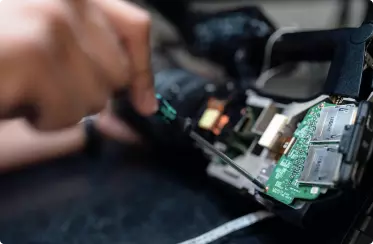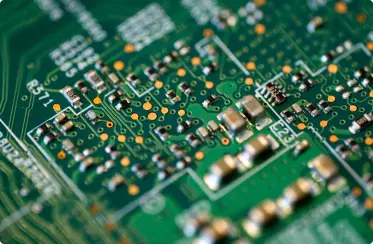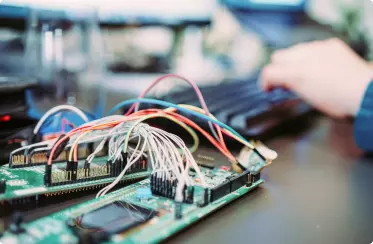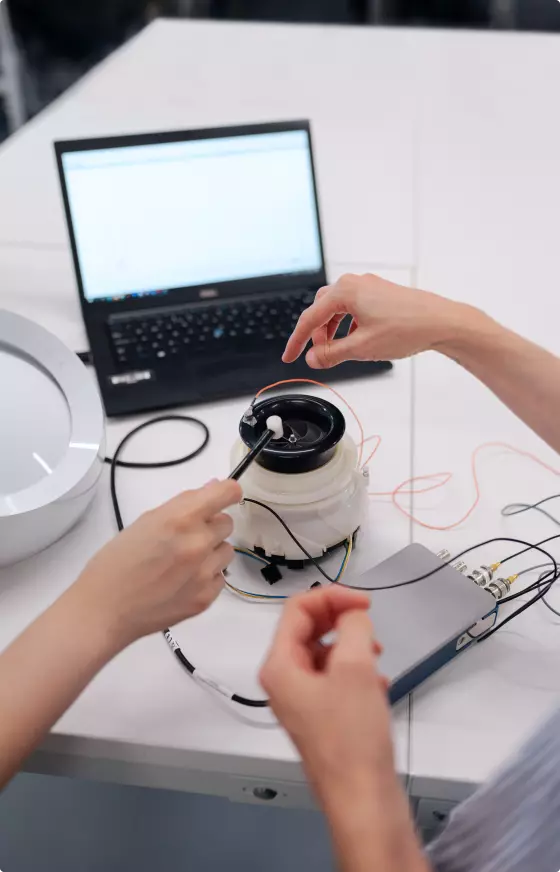We embed your ideas
There are things hidden from our eyes, when using computers, automobiles or medical devices. We don’t usually think about the technology that makes things work. These technologies are called embedded systems, and their development is one of the areas of our expertise.
EMBEDDED DEVELOPMENT SERVICES
We facilitate embedded software development and create custom solutions that fit enterprise-level technical requirements. Embedded development services encompass the full lifecycle of embedded systems, from conceptualization and design to deployment and maintenance.
What is an embedded system?
An embedded system is a specialized system that performs specific tasks within a larger device or system. It consists of hardware, such as a microcontroller, memory, and interfaces, along with software code that controls its functionality.
Embedded systems are designed for dedicated functions, often in real-time, and require minimal human intervention. They are commonly found in consumer electronics, automotive systems, medical devices, and industrial control systems.
What types of embedded systems exist?
Embedded span a wide range of applications, each with its own unique requirements and challenges. These are just a few examples of the types:
Independent and self-contained, performing specific tasks without relying on external devices or networks (household appliances, digital cameras, and portable media players);
Designed to respond to external events or inputs within specific timing constraints (industrial control systems, robotics, and automotive systems).
Connected to a network and can communicate with other devices or systems. They enable data exchange, remote monitoring, and control over network connections. Examples include smart home systems, IoT devices, and networked medical devices.
Designed for mobility and wireless communication. They are used in applications such as smartphones, tablets, wearable devices, and wireless sensor networks.
Utilize a real-time operating system to manage task scheduling, resource allocation, and communication in real-time applications. RTOS-based embedded systems are commonly used in aerospace, defense, and industrial automation.
Include user interfaces to enable interaction between humans and the embedded system. Examples include smartphone touchscreen interfaces, vehicle infotainment systems, and home automation control panels.

For what purposes embedded systems can be used?
Embedded systems are widely used in microprocessors and microcontrollers. They are also applied in portable devices, such as digital watches, earbuds for medical imaging systems, logic controllers, traffic lights, hybrid vehicles, etc. They provide technological advancements and decrease the cost of microprocessors and microcontrollers.
What businesses need embedded systems?
If your business needs automatic regulation and control of technological processes, for example, avionics or access control; or if you use CNC machines, ATMs, payment terminals, or telecommunication equipment, then embedded systems are your best solution. A PCB is employed in the manufacturing of business machines and computers, as well as communication, control and home entertainment equipment. PCBs are an essential part of almost all electric and electronic equipment, and have revolutionized the electronics industry.
How we make it possible
The higher level requirements to the quality of the software and the hardware components distinguish embedded systems from others. An embedded system must be fully tested because errors here can lead to disastrous consequences. Our facilities allow us to do it fully.
The combination of a modern laboratory with cutting-edge equipment and a team of experts makes LANARS one of the most outstanding hardware developers in Europe. Our hardware team includes experienced professionals who have a background in hardware development for the space and aircraft industries — that is why we’ve hired our staff from the heart of the space engineering industry, Ukraine.
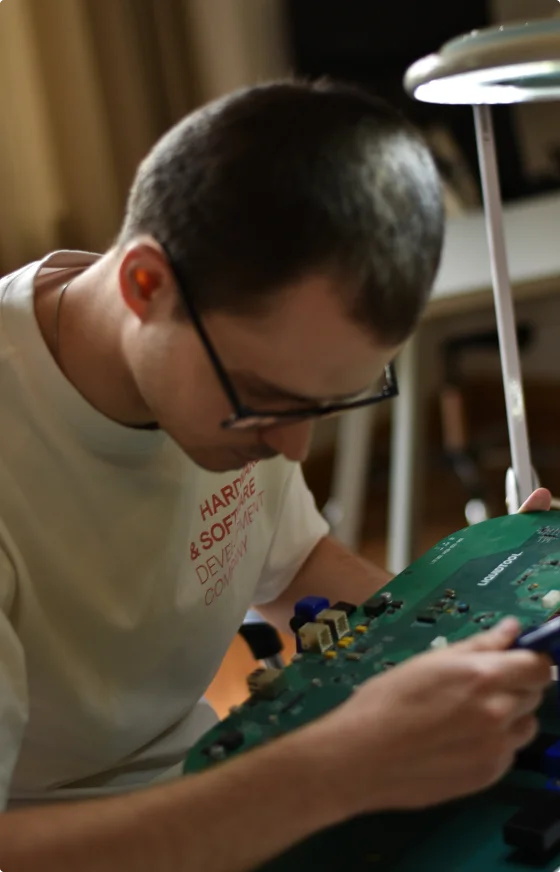
PCB DESIGN AND LAYOUT SERVICES
With a strong reputation in high-speed digital, analog, mixed-signal, and RF systems, LANARS team are trusted experts in PCB design. Our expertise extends to the design of single, double, and high-layer count (up to 32 layers), as well as rigid and flex-rigid printed circuit boards.
Whether your project involves high-speed constraint-driven requirements, complex routing, or basic I/O, our team of experienced engineers and technical staff possess the knowledge and skill to deliver comprehensive designs of exceptional quality.
We pride ourselves on our commitment to excellence, efficient project management, and timely delivery, ensuring that your PCB design needs are met with the utmost precision and professionalism.
PCB SERVICES FROM LANARS
We offer comprehensive PCB design services that cater to your specific needs. Our capabilities include:
Schematic Capture
Translating your design concepts into functional schematics.
Custom Footprint Design
Creating customized footprints to meet your specific requirements.
Board Layout Services
Designing PCB layouts based on customer-supplied schematic diagrams.
Converting Schematics
Converting schematics from various formats (PDF, sketches, etc.) into proper electronics CAD formats.
Reverse Engineering
Recreating PCB designs from existing circuits.
Rigid and Flex PCB Design
Expertise in designing both rigid and flex PCBs, including complex board shapes.
Controlled Impedance and RF Design
Specialized design for controlled impedance, RF, high-speed backplanes, and mid-plane boards.
Component Resequencing and Reverse Annotation
Synchronizing physical layout with the schematic by resequencing components and annotating changes.
Gerber Files and Fabrication Drawings
Delivering fabrication drawings, assembly files, and Gerber files that adhere to manufacturing requirements.
Routing Implementation
Implementing routing per trace/space, keep-out, and clearance rules specified by customers.
DFT Audits and Testability
Conducting Design for Testability (DFT) audits, test point placement, and test probe clearance to ensure efficient testing processes.
Surface Mount and Through-Hole Designs
Accommodating both surface mount and through-hole designs.
Unique PCB Shapes
Creating PCBs with unique and unconventional shapes.
BOM and Part Pricing
Providing complete Bill of Materials (BOMs) and accurate part pricing for each design.
We work with various software for creating custom PCBs
CAD
- Altium (Altium Designer)
- Cadence (ORCAD & ALLEGRO)
- Autodesk (EAGLE)
- Mentor Graphics (PADS), and more.
PCB design
- Cadence (ORCAD & ALLEGRO)
- CADSoft (EAGLE)
- Mentor Graphics (PADS)
- Altium (Altium Designer), and more.
Selected case

Industries where embedded systems are widely used
Embedded for Smart Home
Smart home equipment with embedded technologies can monitor the temperature, humidity, air quality, gas density and water usage of the house, and have infrared sensors. It also can act as a security guard for the home. The network and telephone connection to receive the owner's commands also uses embedded systems.
Embedded for Military
Embedded systems technologies can be applied directly for military purposes (target recognition, navigation of forces, aircraft engineering, and navigation), as well as in healthcare devices developed for the army (automation of trauma monitoring, equipment for treatment, prosthetics, and dialysis, pacemaker, etc).
Embedded for Energy
Whether it’s the measurement of extraction and flow, detecting losses and leaks, or more insight into supply and demand, there is an increasing need for connected devices and systems to measure and provide accurate data. Embedded solutions in these cases are the best ones to use, due to the big changes happening in the energy and utility industry.

Get started with Lanars
Tell us about your project. We respond to every inquiry within one business day. Really!

